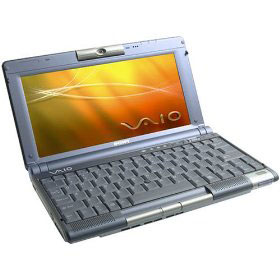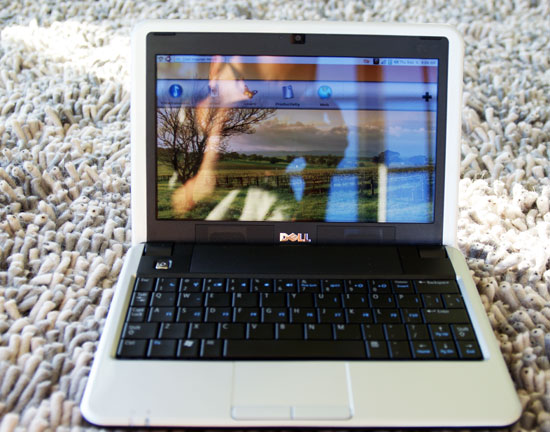Dell Inspiron Mini 9 Reviewed: Refining the Netbook Market
by Anand Lal Shimpi on September 4, 2008 12:00 AM EST- Posted in
- Laptops
Around 6 years ago I owned a Sony Picturebook C1VN. It was based on the horrendously slow Transmeta Crusoe TM5600 CPU, running at 600MHz - at the time it was about as fast as a desktop Celeron 400MHz.

Ah, my beloved Picturebook...how slow you were
(true story, some Intel folks made fun of me for pulling it out at IDF one year before Centrino hit)
The Picturebook was the first ridiculously impractical, but awesomely small notebook I ever owned. It was a pain to type on, slow and the screen was too cramped to get any serious work done. The size was its biggest selling point and for that you paid a premium, over $2,000 if I remember correctly, for the slowest, most impractical notebook you could buy at the time.
In my review of the ASUS Eee Box I talked about this idea of "fast enough" computers. That our desktop (and mobile) hardware has gotten so fast that it's paved the way for an entirely new category of computer, a machine that's not the fastest, but fast enough for things like web browsing and cloud computing. These days it's real easy to have all of your frequently used data stored in the cloud; emails in Gmail, documents online with Google Docs and all of your photos are already online if you like sharing them. You don't need an 8-core Nehalem to get access to your content stored in the cloud, you just need something fast enough.
Intel built its first "fast enough" processor, it's called Atom. Eventually we'll see Atom in smartphones but today it's in computers and mobile internet devices (MIDs). Combine this idea of fast enough hardware with the form factors that were popular during the Picturebook days and you get the netbook.
ASUS really kicked off this latest infatuation with netbooks with its Eee PC, but it’s sort of like what happened when Apple released the MacBook Air. Super thin, ultra portable notebooks had been released for years but since a company as high profile as Apple was now in the game it’s now exposed to a whole new crowd of people.
ASUS made tremendous headway with the Eee PC, bringing a notebook to users who had previously never heard of ASUS much less have any clue how to pronounce the name (AH-soose). But if it was ASUS who helped to create this recent phenomenon, it’s Dell that will make it popular.
Making the Case for Ultra Portables
It's called the Inspiron Mini 9 and it's Dell's entry into the netbook market. Make no mistake, ASUS was the driving force behind the Inspiron Mini 9. Even the naming is ASUS-inspired (the Inspiron Mini 910 vs. the Eee PC 901?). Despite ASUS' head start, Dell had the luxury of watching from a distance and improving where ASUS had failed to make enough changes.

I hate quoting the same review twice on one page but again, in the Eee Box article, I mentioned that it was the type of machine that if you had to ask yourself why you needed one, you probably didn't need to buy one. The Mini is quite similar. It's not practical enough to be a serious workhorse computer, it's what I would view as a 2nd, 3rd or 4th machine. It's something you add to the stable, not the only toy in the arsenal. Dell is even offering a promotion where they'll sell you a Mini for $99 if you buy it alongside some of its notebooks.

It's cute.
I've got a friend, her name is Anne, she works at Dell. I've worked with Anne for years, dating back to when I was still in highschool actually and while going over the Inspiron Mini 9 she recounted a story about her daughter. If you work for Dell and have children, I'd expect you'd get asked for free notebooks all the time. Anne does. She got her daughter a new Dell Studio notebook, but all her daughter does on it is browse the web and update her Facebook profile. Anne views the Inspiron Mini as the perfect notebook for her daughter, and I think I do too.
It's the kind of computer you'd take with you around town to browse the web on, but not for serious work. Writing quick blogs, posting on Facebook walls, IMing, catching up on Digg, are all things you could just as easily do on a smartphone - but it's easier to do on a netbook.
The netbook market exists because the perfect notebook/smartphone device hasn't been made yet. Notebooks aren't thin enough and smartphones aren't big/fast enough. The ultimate, ultra-thin Star Trek tablet just hasn't been invented yet and I suspect it's because we not only lack the UI but the hardware for it.
The Mini and netbooks like it are designed to fill a niche in your computing life, not to dominate it. With that established, let's look at the $349, 2.28 lbs, Dell Inspiron Mini.










55 Comments
View All Comments
rowcroft - Thursday, September 4, 2008 - link
I have an Acer Aspire 1 - $349 for the 120GB HDD, XP (need it for WWAN card), 1GB RAM, but no bluetooth.Still, I think it's a much more compelling offer than either this or the Asus and suggest you get one to evaluate.
strikeback03 - Thursday, September 4, 2008 - link
I think that picture at the bottom of the first page shows why I hate glossy screens.What I am waiting for is someone to come out with a device that falls somewhere between an Epson P5000 and an Archos 5" internet tablet. Run a real OS, have a decent sized hard drive for music and photo downloads, multiple card readers, touchscreen, and the ability to go on the internet occasionally if it is around. Closest netbook is the Wind or possibly the Lenovo it would seem, but I wouldn't plan on typing enough to need a real keyboard.
prophet001 - Thursday, September 4, 2008 - link
seriously, 118 wpm? how in the world did you get that fast? i've been typing everyday for 6 years and I can't type that fast. Any tips?preslove - Thursday, September 4, 2008 - link
I'm torn now between betting the Dell Mini 9 or the EEE pc 1000H. There really isn't any reason to buy EEE 901, since it is more expensive than the 1000H, which is $549.99, and is only .8 pounds lighter. The 1000H has a much roomier keyboard that is supposedly closer to a "real" notebook's keyboard than a netbook.Two major advantages of the 1000H over the Dell, though, are that it comes with an 80 gig hd and a 6 cell battery. Also it comes with 1 gig of Ram standard.
Adding all the options to the Dell, Win XP, ram upgrade, camera upgrade, and bluetooh and it adds up to $494. That's $65 less than the 1000H, which has a better keyboard and a good sized hard drive, but is about a pound heavier.
I wish these two were in stores so I could compare the weight and keyboards, as that would probably help be choose.
One question: Can the Mini accept a 2 gig stick of Ram?
tayhimself - Thursday, September 4, 2008 - link
Yes 2 GB RAM interest here too. The Acer Aspire looks good to me as well.JarredWalton - Thursday, September 4, 2008 - link
10" netbooks actually start to become viable as a full-time laptop... almost. I'm not Ben, but I'm right with him in terms of typing on these things. I draw the line of comfort at 13.3" notebooks. Predictive typing would help some, but with the width of my shoulders I still end up feeling cramped on anything smaller. (Why can't I get a natural keyboard on a laptop? LOL)However, the above said, 10" is still small and I think too many people are looking at these as a full notebook/desktop replacement rather than a mobile device that supplements regular computer use. 2GB RAM and 80GB HDDs... and then next we'll need faster CPUs and discrete GPUs, and an optical drive, and.... It's a slippery slope, and I think you should either get a real notebook (13.3" or larger - or 12.1" if you don't mind the smaller keyboards) or understand that the netbook is not supposed to be a full notebook and use it as intended. For $350, the Dell Mini looks extremely promising.
n0nsense - Thursday, September 4, 2008 - link
I think the perfect one should be:1. Little bit more powerful processor (Atom dual core or AMD X2)
2. More advanced chipset (less heat more graphics performance and output options) which will allow playback of 1080p on TV.
3. Normal 2.5" HDD/SDD options for upgrade.
4. I would like touchscreen (multi touch is even better)
The rest i think is very close to be perfect.
The reason is for all this more performance is:
Try to listen to some last.fm radio on the web + some fullscreen flash web page or game.
And yes, i know, all this "more" will kill more expensive notebooks.
psychobriggsy - Friday, September 5, 2008 - link
1) Yes, a dual-core Atom would be nice, but it is already multi-threaded (whoa, what's up with this text box, it's gone all funky!)1b) AMD (soon will) have a 22W 1.5GHz X2. I don't know how much power it uses when PowerNow! is enabled, but AMD need to get a standard Athlon 64 out first that has PowerNow! ranges starting from 400MHz at very low voltage first. They do have a 15W Athlon 64 coming out soon as well.
2) This is the most important aspect, and where all the Atom netbooks are failing right now. It's almost criminal.
3) Really unimportant, these are mobile companions. Bet Palm feels stupid in cancelling the Foleo, when it turns out that form factor is what people want.
4) That Dell Linux interface would be perfect for touchscreen.
JarredWalton - Friday, September 5, 2008 - link
You do know that Atom N270 is like 1.5W TDP, right? http://download.intel.com/design/processor/datasht...">Reference A 22W 1.5GHz X2 would use over 10X as much power as the N270. The problem right now is the chipset; we need Poulsbo.psychobriggsy - Friday, September 5, 2008 - link
And the multi-threaded Atom is 2.5W, and the 64-bit Atom is 4W, and the dual-core Atom will be 8W.Also Paulsbo will suck, it's designed for MIDs, maybe the netbooks will be okay with it, but barely. It's a 130nm chip so however cool running the process they are using, it's limiting the clock speed of the GPU, and the number of features it can have.
AMD have an 8W Athlon 64 already, and in reviews the platform consumes less power and outperforms Atom - in a desktop scenario.